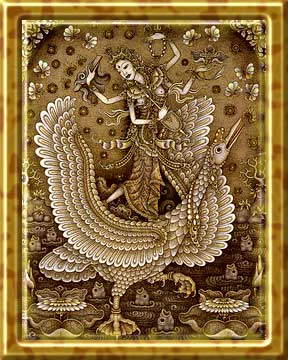

by Saraswati is the Goddess of leaming, knowledge, and
wisdom. The Sanskrit word sara means "essence" and swa means
"self." Thus Saraswati means "the essence of the self."
Saraswati is represented in Hindu mythology as the divine consort
of Lord Brahma, the Creator of the universe. Since knowledge is necessary
for creation, Saraswati symbolizes the creative power of Brahma. Goddess
Saraswati is worshipped by all persons interested in knowledge, especially
students, teachers, scholars, and scientists. In Her popular images and pictures, Goddess Saraswati is generally depicted with four arms (some pictures may show only two arms), wearing a white sari and seated on a white lotus. She holds a book and a rosary in Her rear two hands, while the front two hands are engaged in the playing of a lute (veena). Her right leg is shown slightly pushing against Her left leg. She uses a swan as Her vehicle. There is a peacock by Her side gazing at Her. This symbolism illustrates the following spiritual ideas: * The lotus is a symbol of the Supreme Reality, and a white lotus also denotes supreme knowledge. By sitting on a lotus, Saraswati signifies that She is Herself rooted in the Supreme Reality, and symbolizes supreme knowledge. The white color symbolizes purity and knowledge. The white sari that the Goddess is wearing denotes that She is the embodiment of pure knowledge. * The four amms denote Her omnipresence and omnipotence. The two front amms indicate Her activity in the physical world and the two back arms signify Her presence in the spiritual world. The four hands represent the four elements of the inner personality. The mind (manas) is represented by the front right hand, the intellect (buddhi) by the front left hand, the conditioned consciousness (chitta) by the rear left hand, and the ego (ahankara) by the rear right hand. * The left side of the body symbolizes the qualities of the heart and the right side symbolizes activities of the mind and intellect. A book in the rear left hand signifies that knowledge acquired must be used with love and kindness to promote prosperity of mankind. * The rosary signifies concentration, meditation, and contemplation, leading to samadhi, or union with God. A rosary in the rear right hand representing ego conveys that true knowledge acquired with love and devotion melts the ego and results in liberation (moksha) of the seeker from the bondage to the physical world. * The Goddess is shown playing a musical instrument that is held in Her front hands, which denote mind and intellect. This symbol conveys that the seeker must tune his mind and intellect in order to live in perfect harmony with the world. Such harmonious living enables the individual to utilize acquired knowledge for the welfare of all mankind. * Two swans are depicted on the left side of the Goddess.
A swan is said to have a sensitive beak that enables it to distinguish
pure milk from a mixture of milk and water. A swan, therefore, symbolizes
the power of discrimination, or the ability to discriminate between
right and wrong or good and bad. Saraswati uses the swan as Her carrier.
This indicates that one must acquire and apply knowledge with discrimination
for the good of mankind. Knowledge that is dominated by ego can destroy
the world. http://www.p-g-a.org/PGA-journal-2002.html
<<<PGA DIRECTORY & JOURNAL 2002
The 9 Gems Gemstone Conflicts PG Articles <<<Check for UPDATES Planets & Gems Sidereal Astrology The PGs Dictionary PGA Patrons & Members PG Reference Material <<<IMPORTANT ADDITIONS Planetary Gemology Service Providers (The WWW's largest listing) <<<over 100 A Contemporary International View of Planetary Gemology Featured Talismans <<<Please contribute your PICS and promote your work for FREE >>>Return to PGAs HomePage The Sanskrit name for the PGA was composed by HONORARY PATRON Prof. Dr. Satya Vrat Shastri, Padma Sri |
